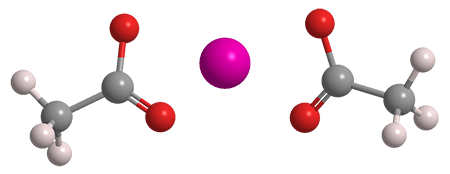What molecule am I?


Lead(II) acetate [Pb(OAc)2] is an inorganic salt with several uses, notably as an ingredient in dyes and mordants. Even though it is highly toxic (see the hazard information table), in the past it has been used as a sweetener and preservative in wines and other foods. It is commercially available as the anhydrous salt or the trihydrate1.
One of the earliest literature mentions of Pb(OAc)2 was in the 21st article in an 1878 series about polyiodides (e.g., KI3) by George Stillingfleet Johnson at King’s College London. Several articles from the 1890s cite Pb(OAc)2 in tests for whether it precipitates the anions of sodium or potassium salts under discussion. One of the salts was derived from what Pietro Biginelli at the University of Florence called “saligeninoxyacetic acid”, now more properly named 2-[2-(hydroxymethyl)phenoxy]acetic acid2.
Pb(OAc)2 can be made by boiling metallic lead in acetic acid in the presence of an oxidant; dissolving lead(II) oxide in acetic acid; or treating copper(II) acetate with the metal. The anhydrous salt and the trihydrate both have monoclinic crystal structures.
1. CAS Reg. No. 6080-56-4.
2. CAS Reg. No. 97388-49-3.
Lead(II) acetate hazard information*
| Hazard class** | GHS code and hazard statement | |
|---|---|---|
| Serious eye damage/irritation, category 1 | H318—Causes serious eye damage | |
| Germ cell mutagenicity, category 2 | H341—Suspected of causing genetic defects | |
| Carcinogenicity, category 2 | H351—Suspected of causing cancer | |
| Reproductive toxicity, category 1A | H360—May damage fertility or the unborn child | |
| Effects on or via lactation (additional category) | H362—May cause harm to breast-fed children | |
| Specific target organ toxicity, single exposure, blood and nervous systems and kidneys, category 1 | H370—Causes damage to blood and nervous systems and kidneys | |
| Specific target organ toxicity, repeated exposure, blood, immune, and central nervous systems and kidneys, category 1 | H372—Causes damage to blood, immune, and central nervous systems and kidneys through prolonged or repeated exposure | |
| Short-term (acute) aquatic hazard, category 1 | H400—Very toxic to aquatic life | |
| Long-term (chronic) aquatic hazard, category 1 | H410—Very toxic to aquatic life with long-lasting effects | |
*Compilation of multiple safety data sheets , some for the trihydrate.
**Globally Harmonized System (GHS) of Classification and Labeling of Chemicals. Explanation of pictograms.
Molecules from the journals
Acalabrutinib1 is a medication for treating non-Hodgkin lymphomas, such as mantle-cell lymphoma, and some leukemias. It was approved for use by the US Federal Drug Administration in 2017 and by the European Medicines Agency in 2020. Last December, Michael Golden at AstraZeneca (Macclesfield, UK) and collaborators there and in the United States described the development of an efficient commercial manufacturing process for acalabrutinib.
D-Arabitol2, also called D-arabitinol, is a five-carbon sugar alcohol that has been known since at least 1899, when Otto Ruff at the University of Berlin made it by reducing D-arabinose3 or D-lyxose4 with sodium. Found in nature in mushrooms and other fungi, it has had few applications over the years. But last December, Xianghui Qi and co-workers at Jiangsu University (Zhenjiang, China) reported that D-arabitol, in conjunction with gut bacteria, may help to ameliorate obesity and metabolic disorders.
1. CAS Reg. No. 1420477-60-6.
2. CAS Reg. No. 488-82-4.
3. CAS Reg. No. 10323-20-3.
4. CAS Reg. No. 1114-34-7.
Molecules from the Journals
MOTW briefly describes noteworthy molecules that appeared in recent ACS journal articles. See this week's
edition below.
This molecule was suggested by a reader. We present almost all of the molecules suggested by our readers. If you have a molecule you would like us to consider, please send us a message. And thank you for your interest in Molecule of the Week! —Ed.
Lead(II) acetate fast facts
| CAS Reg. No. | 301-04-2 |
| SciFinder nomenclature | Acetic acid, lead(2+) salt (2:1) |
| Empirical formula | C4H6O4Pb |
| Molar mass | 325.29 g/mol |
| Appearance | White crystals, granules, or powder |
| Melting point | 280 °C |
| Water solubility | 443 g/L (20 °C) |

Learn more about this molecule from CAS, the most authoritative and comprehensive source for chemical information.
Molecule of the Week needs your suggestions!
If your favorite molecule is not in our archive, please send us a message. The molecule can be notable for its current or historical importance or for any quirky reason. Thank you!
Stay Ahead of the Chemistry Curve
Learn how ACS can help you stay ahead in the world of chemistry.

